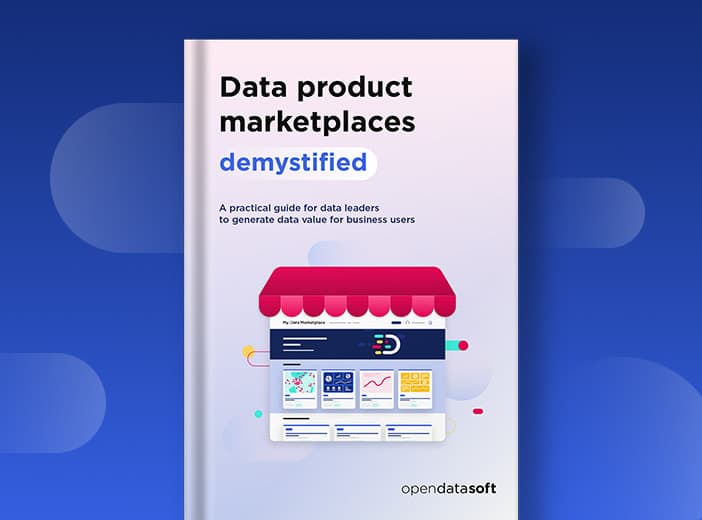6 high-ROI use cases for data product marketplaces in the insurance sector
The insurance sector faces rising pressure on margins and a need to meet increasing regulatory requirements. With costs and claim volumes growing, insurers need to rethink their data sharing strategies to increase consumption and value to boost efficiency and innovation.

Demonstrating the need to transform data sharing, over 80% of insurance data leaders are prioritizing projects to share their data through a single access point, according to our latest research.
To meet this pressing requirement, more and more insurers are therefore focusing on data product marketplaces. These drive data consumption at scale, improving operations, unlocking new revenues and modernizing technology stacks.
In this article we’ll explain how data product marketplaces reduce both operational costs associated with data management and drive greater value across all facets of the insurance business, including customer relations, launching new services, meeting regulatory obligations and optimizing IT budgets. We’ll showcase these benefits with actual use cases from leading insurers to show the real-world impact that data marketplaces deliver.
Case 1: Optimizing the data stack - a data product marketplace to structure and enhance fragmented data
Insurers are complex, large-scale organizations, meaning that their data is often scattered across the business, isn’t collected systematically, is under-exploited and doesn’t meet quality requirements. Data is siloed across different systems, inside the business and externally across partners. This prevents a global view of policyholders, contracts and claims, leading to inconsistencies and complicating the use of data for analytical or operational purposes.
A data product marketplace overcomes these challenges by structuring and centralizing data from multiple sources. It ensures data interoperability, improves quality and automates data processing, resulting in high-quality data that in turn makes analysis and reporting more accurate and timelier.
For example, a mutual insurance company can deploy a data product marketplace to aggregate multi-source data and provide self-service access to all relevant stakeholders, including employees and partners. By qualifying and consolidating this data, it can reduce the time spent manually checking information by up to half, and significantly improve the detection of fraud.
Real-world example: French mutual insurer Lamie Mutuelle has transformed its data approach thanks to its data marketplace, centralizing and structuring data to offer employees a 360° view of its members. It has optimized access to key information, improved the personalization of services and increased internal efficiency. The result: rapid user adoption and significant time savings of around three days per month for the business.
Case 2: Improving the customer relationship - a data product marketplace to improve service quality for policyholders
Customer experience is a key differentiator for insurers and mutual insurance companies, meaning they need to respond quickly to incoming queries and offer personalized services to policyholders. A data product marketplace delivers the right data to customer service advisors, improving their responsiveness and enabling them to provide policyholders with a more fluid experience, while allowing the launch of innovative new services.
By centralizing all customer information and facilitating access via an intuitive, self-service experience, insurers can better anticipate customer needs, speed up claims management and offer more accurate product and policy recommendations.
For example, a mutual insurance company can use a data product marketplace to give its agents quick access to member data, reducing application processing time by around 40% and improving policyholder satisfaction.
Real-world example: Lamie Mutuelle centralizes all of its data and makes it available to employees through its data marketplace. As data is in a consistent, understandable format it can be easily integrated into other business applications and used within new services. Thanks to these actionable insights employees are able to create new products based on customer needs, improving satisfaction and retention.
Case 3: Boosting innovation - a data product marketplace to leverage external data and improve insurance products
Insurers now need to integrate a wide range of external data (such as weather, economic, geographical or socio-demographic information) into their data stack. This is vital to adapting their products, delivering personalized policies, better managing risk and accurately pricing every service they offer. However, often this data comes from a range of external sources and is provided in multiple different formats, complicating its internal use in the organization.
A data product marketplace centralizes and standardizes external information, sharing it across the business in real-time.
Some concrete examples:
- An actuary can drill down into claims histories and cross-reference them with weather data to refine pricing models.
- A pricing manager can test different premium scenarios based on changing customer behaviors.
- A product manager can access real-time dashboards on claims trends by region to adjust their offers.
- A broker can access personalized offers in real-time based on customer histories.
Case 4: Monetizing data - a data product marketplace to drive growth and new opportunities
Sharing data across the insurance ecosystem with third-party players such as fintechs, brokers and reinsurers creates new opportunities for insurers. They can improve collaboration and build new revenues by monetizing data and accelerating the development of innovative services.
A data product marketplace makes it possible to provide partners with secure, compliant access to data, such as by offering premium APIs to share risk scores or creating subscription services. Granular access rights can limit partners to specific data to ensure confidentiality. This approach fosters a collaborative ecosystem and the introduction of new services based on enriched data.
Example: An insurer can generate additional revenue by offering a premium API that allows its brokers to access real-time risk scores, improving conversion rates by 15% or more.
Case 5: Modernizing the tech stack - a data product marketplace as part of data architecture transformation
Given their size, complexity and age, many insurers’ IT systems are expensive to manage and difficult to integrate internally or externally, adding to costs and hindering information sharing.
Introducing a data product marketplace helps modernize information systems by pooling resources and optimizing data management. It enables better interoperability through APIs and microservices, facilitating the seamless exchange of information between systems.
Example: By deploying a data product marketplace to streamline their technology, mutual insurers can reduce infrastructure costs by up to 30%, all while improving integration with partners.
In the case of Lamie Mutuelle, the insurer has made its data product marketplace the central building block of its information system. In addition to reducing costs, this allows it to:
- Use the processors provided by the platform to standardize its data and allow its reuse.
- Share data via APIs to feed its CRM and member areas.
- Benefit from advanced, granular access management of data marketplace users, ensuring regulatory compliance.
Case 6: Reducing costs - a data product marketplace to increase the operational efficiency of analysts and agents
Insurance companies have to manage huge volumes of data (contracts, claims, risks, customers, partners), often stored in separate, siloed systems. This fragmentation leads to high costs and makes it inefficient to find and cross-reference information, leading to wasted time, duplication of tasks, and reduced team productivity.
With a data product marketplace, flows are automated, reducing data management costs by an average of 20-30%. Easier access to information also improves the efficiency of business analysts, while boosting customer satisfaction. Together, this delivers significant operational gains from time savings, optimizing the purchase of external data, and greater efficiency.
Example: a mutual insurance company can centralize its contract data via a data product marketplace and thus reduce its document management costs by around 25% by providing a single way to access information, improving agent responsiveness and productivity.
MAIF – data sharing in action
Mutual insurance company MAIF has made data sharing at scale a strategic driver to optimize its operations and strengthen the autonomy of its business teams. It is aiming to move from a centralized data stack that was receiving a growing volume of requests from the business, to a data product marketplace where data is easily consumed by business users via self-service.
MAIF’s approach focuses on centralizing data and processing it to make information intelligible and accessible. Its data marketplace makes it simple for business users to discover and explore related data products and datasets. This is delivered through:
- Better data organization to make it consumable by all.
- The creation of blended teams that bring together business users, data analysts and data scientists to provide a full range of necessary skills and experiences.
- Business self-service that empowers the customer service and analytics departments.
A concrete example: MAIF’s Geo Data Hub
To respond to climate challenges, MAIF has created a Climate Unit, combining data expertise and risk modelling. This has resulted in its Geo Data Hub, which centralizes data on climate hazards to refine risk analysis around the possibility of droughts, storms, or floods, and makes this available to the wider business.
Data sharing: a strategic imperative for all insurers
In a changing sector, insurers face growing competition and need to account for a more complex risks while meeting regulatory requirements and customer needs for more personalized products. This makes data product marketplaces essential for combining operational performance, innovation and digital transformation, enabling insurers to optimize costs, enhance the value of their data, and modernize their IT infrastructure.
Players who adopt this approach will remain ahead of the curve, ensuring data management is reliable, efficient, and actionable at scale. The future of insurance is based on data, with data product marketplaces the catalyst for its sharing and consumption across the business and wider ecosystem.
Want to transform your insurance data management? Contact our experts to learn more!



